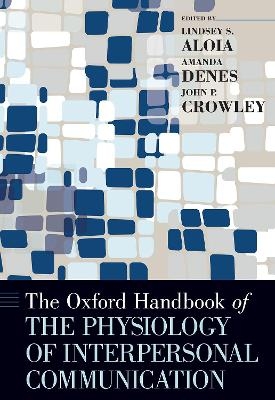
The Oxford Handbook of the Physiology of Interpersonal Communication
Oxford University Press Inc (Verlag)
978-0-19-067944-6 (ISBN)
Communication scholars have long recognized the importance of understanding associations between our bodies and communication messages and processes. In the past decade, there has been an increased focus on the role of physiology in interpersonal interactions, resulting in a surge of research exploring topics related to communication in close relationships. This growing line of research explores topics such as affectionate communication, forgiveness, communication apprehension, and social support. Contributing to the increase in physiological research on communication processes is a greater recognition of the bi-directional nature of the associations between communication and the body. Researchers study both the physiological outcomes of communication episodes (e.g., stress responses to conflict conversations), as well as the effects of physiology on communication process (e.g., the influence of hormones on post-sex communication).
The Oxford Handbook of the Physiology of Interpersonal Communication offers a comprehensive review of the most prolific areas of research investigating both the physiological outcomes of interpersonal communication and the effects of physiology on interpersonal interactions. This volume brings together thirty-three leading scholars in the field and draws on research from communication studies, physiology, psychology, and neuroscience. Based on quantitative research methods, the Handbook serves as a resource for both researchers and students interested in investigating the mutual influence of physiology and communication in close relationships.
Lindsey S. Aloia is an Assistant Professor in the Department of Communication and the Director of the Center for Communication Research at the University of Arkansas. Amanda Denes is an Associate Professor in the Department of Communication at the University of Connecticut. John P. Crowley is an Assistant Professor in the Department of Communication at the University of Delaware.
Chapter 1: Locating Physiology in the Study of Interpersonal Communication
Lindsey S. Aloia, Amanda Denes, John P. Crowley
Chapter 2: Conceptualizing and Measuring Affective and Cognitive Empathy: Physiological Bases of Discrete Emotion Communication, Reason, and Involvement in Decision Making
Ross Buck, Zhan Xu
Chapter 3: The Physiology of Affectionate Communication
Kory Floyd, Corey A. Pavlich, Dana R. Dinsmore, Colter D. Ray
Chapter 4: The Physiology of Social Pain: Examining, Problematizing, and Contextualizing the Experience of Social Pain
Anita L. Vangelisti, Nicholas Brody
Chapter 5: Understanding Physiological Associations with Emotional Competence
Colin Hesse
Chapter 6: Relational Transitions and Stress: Turbulence over the Lifespan of Marriage
Kellie St. Cyr Brisini, Denise Haunani Solomon
Chapter 7: Selected Physiological Dimensions of Communication Apprehension
Michael J. Beatty, Andrea Martinez Gonzalez
Chapter 8: The Physiology of Conflict, Verbal Aggression, and Violence
Lindsey S. Aloia
Chapter 9: Enacting the Demand/Withdrawal Pattern and Physical Well-Being
Michael E. Roloff, Rachel M. Reznik
Chapter 10: Emotional Support Processes and Physiology: A Dyadic Perspective
Jennifer S. Priem
Chapter 11: The Physiology of Forgiveness
John P. Crowley, Ryan J. Allred
Chapter 12: Resilience through Stress: Advancing the Theory of Resilience and Relational Load
Tamara D. Afifi, Michelle Acevedo Callejas, Kathryn Harrison
Chapter 13: The Hormonal Underpinnings of Sexual Communication
Amanda Denes, Anuraj Dhillon, Ambyre Ponivas, Kara L. Winkler
Chapter 14: Evoking Issues of Race and Ethnicity in Research on Physiology and Interpersonal Communication
Shardé M. Davis
Chapter 15: The Psychobiology of Listening: Why Listening is More than Meets the Ear
Graham D. Bodie, Andrew D. Wolvin
Chapter 16: Real or Not Real? Interpersonal Communication via Digital Platforms and Subsequent Physiological Outcomes
Jeanine W. Turner, James D. Robinson, Alexandra McCarthy
Chapter 17: Future Directions for Physiological Communication Research
Amanda Denes, John P. Crowley, Lindsey S. Aloia
| Erscheinungsdatum | 13.08.2020 |
|---|---|
| Reihe/Serie | Oxford Handbooks |
| Verlagsort | New York |
| Sprache | englisch |
| Maße | 175 x 249 mm |
| Gewicht | 794 g |
| Themenwelt | Geisteswissenschaften ► Psychologie ► Sozialpsychologie |
| Studium ► 1. Studienabschnitt (Vorklinik) ► Physiologie | |
| Sozialwissenschaften ► Kommunikation / Medien ► Kommunikationswissenschaft | |
| ISBN-10 | 0-19-067944-1 / 0190679441 |
| ISBN-13 | 978-0-19-067944-6 / 9780190679446 |
| Zustand | Neuware |
| Haben Sie eine Frage zum Produkt? |
aus dem Bereich


